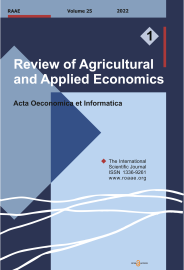KEYWORDS:
aquafarming; household welfare; postharvest loss
DOI NUMBER:
10.15414/raae.2022.25.01.87-93
ABSTRACT:
Research background: The trend in aquafarming has been increasing over the years, thereby meeting the deficit in fish production caused by capture fisheries. Aquafarming is a source of income and food for most Kenyan populations. Despite the increased fish production, postharvest losses in fish production have remained a challenge over the years. These postharvest losses resulted from high transport costs, poor preservation methods, inadequate storage facilities, and poor handling and mismanagement. The postharvest losses result in quality and quantity losses in fish production, thereby affecting the income received by farmers.Purpose of the article: This paper analyses the effects of postharvest losses on household welfare among aquafarmers in Kenya.
Methods: Primary data was collected in Kiambu, Kirinyaga, Nyeri, Kakamega and Siaya Counties in Kenya. Semi-structured questionnaires were used to collect the data on a sample size of about 300 farmers. This study used a two stage least square was used to analyse the effects of postharvest losses on household welfare. Access to preservation facilities and distance to the market were considered instrumental variables in the model.
Findings & Value added: Results indicated that postharvest losses were negatively significant on household welfare. On the other hand, farmer’s age, ownership of land, and the size of land under crop were also significant on household welfare. Due to inaccessible markets, postharvest losses result in to decline in farmers' income, hence welfare loss. The study recommended investment in preservation facilities and road infrastructure to reduce the number of postharvest losses in fish in an attempt to improve the welfare of farmers.
Please Cite this Article as:
Jack Odhiambo MALIT, Mary Wairimu Kiiru MATHENGE, Augustus MULUVI (2022) Influence Of Postharvest Losses On Household Welfare Among Aquafarmers In Kenya. Review of Agricultural and Applied Economics. XXV (Number 1, 2022): 87-93. doi: 10.15414/raae.2022.25.01.87-93
URL for sharing:
https://roaae.org/1336-9261/doi/abs/10.15414/raae.2022.25.01.87-93
FULL TEXT PDF:
▼ direct download link| view online in fullscreen ▲
References:
▼ direct download link

